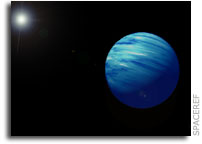Hybrid Mechanisms for Gas/Ice Giant Planet Formation

http://images.spaceref.com/news/extrasolar.28.jpg
Astrophysics, abstract
astro-ph/0409730
From: Thayne Currie [view email]
Date (v1): Wed, 29 Sep 2004 18:45:15 GMT (18kb)
Date (revised v2): Wed, 20 Apr 2005 17:21:13 GMT (23kb)
Hybrid Mechanisms for Gas/Ice Giant Planet Formation
Authors:
Thayne Currie (UCLA)
Comments: 8 pages, 3 figures, 12pt preprint, emulateapj style; two sections
added addressing shear-dominated accretion & disk conditions necessary for
GI; Accepted for publication in the Astrophysical Journal
The effects of gas pressure gradients on the motion of solid grains in the
solar nebula substantially enhances the efficiency of forming protoplanetary
cores in the standard core accretion model in ‘hybrid’ scenarios for gas/ice
giant planet formation. Such a scenario is enhanced core accretion which
results from Epstein-drag induced inward radial migration of mm-sized grains
and subsequent particle subdisk gravitational instability needed to build up a
population of 1 km planetesimals. Solid/gas ratios can be enhanced by nearly
$\sim 10\times$ over those in Minimum Mass Solar Nebula (MMSN) in the outer
solar nebula (a $>$ 20 AU), increasing the oligarchic core masses and
decreasing formation timescales for protoplanetary cores. A 10 $M_{\oplus}$
core can form on $\sim 10^{6}-10^{7}$ year timescales at 15 – 25 AU compared to
$\sim 10^{8}$ years in the standard model,alleviating the major problem
plaguing the core accretion model for gas/ice giant planet formation.
Full-text: PostScript, PDF, or Other formats
References and citations for this submission:
SLAC-SPIRES HEP (refers to ,
cited by, arXiv reformatted);
CiteBase (autonomous citation navigation and analysis)
Which authors of this paper are endorsers?








